
by Barbara Klein
Scientists agree that the list of species in danger of extinction due to climate change is long. Very long.
But according to a group of economists and scholars collectively known as the Climate Impact Lab, that list must also include our nation’s poor.
In their new study published in Science magazine, professors Solomon Hsiang of the University of California, Berkeley and Robert Kopp of Rutgers University crunched the numbers and found that if climate change continues unabated, the country’s most-in-need populations will experience the most devastation.
Focusing on the 3,140-plus counties in the United States, the research measured 29,000 potential outcomes based on different temperature and economic variables.
As reported in the Washington Post, here is what they concluded. “The poorest third of counties—many of them in the South and lower Midwest—could sustain economic losses by the last decades of this century that would be comparable to those suffered during the Great Recession.
“The Gulf Coast would face major risks from hurricanes and encroaching seas,” the article continued. “Higher temperatures in the South would drive up air-conditioning costs and hamper productivity. Agriculture in the Midwest could see losses on par with the Dust Bowl of the 1930s.”
But the big difference, Hsiang pointed out, is that “these changes are here to stay.”
In terms of the bottom line, The Atlantic summed it up this way: “Overall, the paper finds that climate change will cost the United States 1.2 percent of its GDP for every additional degree Celsius of warming.”
More specifically, the stats suggest that our nation’s poorest 100 counties will experience an average loss of 11 percent of their GDP due to climate change while the richest 100 counties will lose just 1 percent.
Although the study dealt primarily with the United States, its global predictions were equally ominous. It seems there is no place on Earth where climate change won’t disproportionately impact the poorest people in the poorest nations.
The Anthropocene is the current geological era in which humans are making a profound impact on the geological strata. While the term itself is still being debated by geologists, the museum is embracing it as a social and cultural tool for exploring the broad sum effect humans are having on the planet in the exhibition We Are Nature: Living in the Anthropocene—open now through summer 2018.
